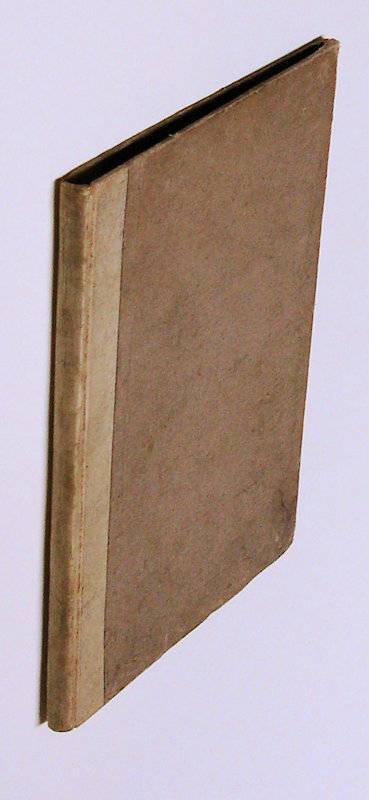BAÏF, L. DE.
De vasculis libellus, adulescentulorum causa ex Bayfio decerptus, addita vulgari latinarum vocum interpretatione.
Paris (Parisiis), Ex officina Roberti Stephani typographi Regii, 1543. (Colophon at the end: 'Excudebat Rob. Stephanus Typographus Regius, Parisiis, an. M.D.XLIII, XIII Cal. Oct.)
8vo. 52,(3 index),(1 blank) p. Half vellum (20th century) 17 cm (
Ref: not in Renouard, 'Ann. de l'Impr. des Estienne', see however p. 58, 1543/12: 'Carolus Stephanus, De re Vestiaria, Vascularia et Navali, ex Bayfio. Addita vulgaris linguae interpretatione'; not in Brunet, Graesse, or Ebert) (
Details: Printer's Olive tree device of the Stephanus family on the title, motto: 'Noli altum sapere', short for 'Noli altum sapere, sed time', in English 'Donot be high-minded, but fear'. (Epistola Beati Pauli ad Romanos 11,20) (
Condition: The right upper corner of the first gathering slightly waterstained) (
Note: The French diplomat, humanist and poet Lazare de Baïf, ca. 1496-1547, was born near La Flèche in Anjou. He wrote in Latin and translated from Greek into French. He translated the Electra of Sophocles which was printed in 1537 in Paris. He was abbot of Charroux and Grenetière, and counselor of the parliament of Paris. Around the year 1530 Baïf was sent to Venice as ambassador, where he fell in love with a woman of rank, with whom he had a son in 1532. The boy was named Jean-Antoine, the future poet of the Pléiade. Lazarus de Baïf, being of ecclesiastical orders, could of course not marry his mistress, but he recognized her son and legitimized him later. He took the boy to Paris where he gave him a worthy education. Some of his tutors were Dorat, a brilliant Hellenist and Latin scholar, and Charles Estienne, his friend and disciple. In 1526 De Baif published his first work in Basel
De re vestiaria, which earned him a reputation among French scholars, as second in rank to Guillaume Budé. As a diplomat he continued his philological and archaeological studies, and corresponded with Erasmus, Bembo and many other humanists. 'His scholarly reputation rests squarely on his three Latin works:
De re vestiaria of 1526 (...)
De vasculis, Basel, H. Froben, 1531, (...) and finally
De re navali, Paris, R. Estienne 1536' which was accompanied by illustrations derived from sketches of the pillar of Trajan and other monuments. (Contemporaries of Erasmus: A Biographical Register of the Renaissance and Reformation, Toronto 1985, p.87/88) In 1549 Robert Estienne posthumely published an edition of these works which were revised and expanded by the author. Charles Estienne rearranged de Baïfs works on naval matters, clothing and vases of the ancients for the use of young students. (Various editions between 1535 and 1537) The first 'school-edition' of the book on ancient vases came from the presses of Robert Estienne in 1536, and was repeated in Basel by Froben in 1537 and 1541. (
De vasculis libellus, adulescentulorum causa ex Baysio decerptus. Addita vulgari Latinarum vocum interpretatione) In the preface to
De Vasculis Charles Estienne tells the reader that not all (aliquot) studious young students (iuniores tyrunculi) could understand De Baif's work. (se non omnia intelligere quae in libello Bayfii de vasculis continerentur). Therefore, when he heard this, De Baif gave his friend permission to make a summary of his book. (facile passus est suum libellum in brevem quandam summulam contrahi) Charles Estienne 1504-1564, 'was an early exponent of the science of anatomy in France. Charles was a younger brother of Robert Estienne I, the famous printer, and son to Henri, who Latinized the family name as Stephanus' (...) After the usual humanistic training (Greek and latin classics) he studied medicine, and took his doctor's degree at Paris. He was for a time tutor to Jean-Antoine de Baïf, the future poet. It is uncertain whether he taught publicly. His career was interrupted by the oppressive persecutions in which their religious opinions involved the family. (Wikipedia s.v. Charles Estienne) Robert Estienne published De Baifs work on vases in the same year (1543) also accompanied by a French translation (See Renouard)
§ This 1543 edition seems to be rare. KVK records only a few copies worldwide) (
Collation: a-c8, d4) (Photographs on request)
Book number: 120164 Euro 800.00
Keywords: (Oude Druk), (Rare Books), Archeologie, Classical art and archaeology, Estienne, Schulbuch, Stephanus, antike altertum antiquity, archaeology, klassische Kunst & Archaeologie, schoolbook, vases
 BAÏF, L. DE.
BAÏF, L. DE.